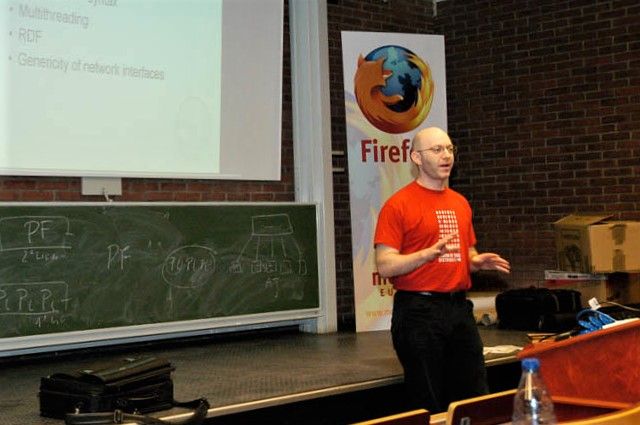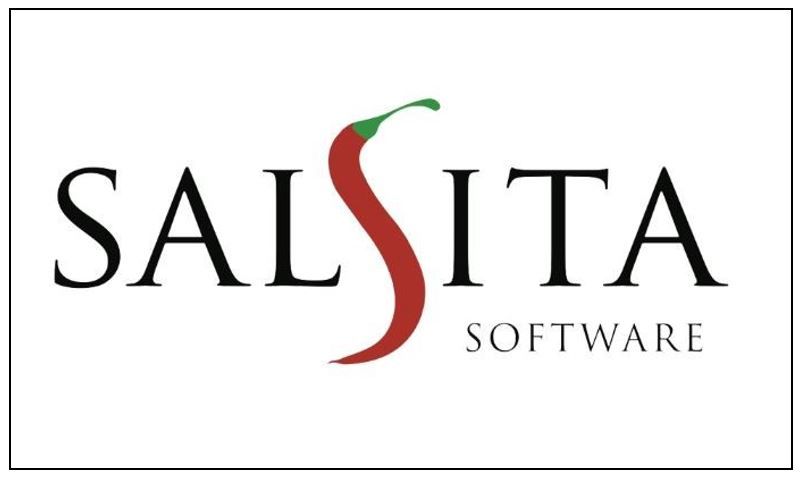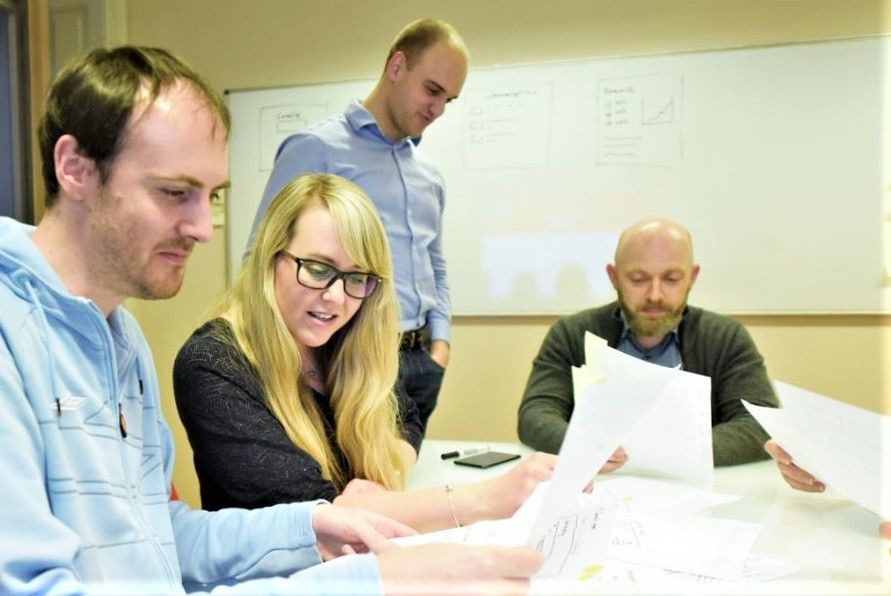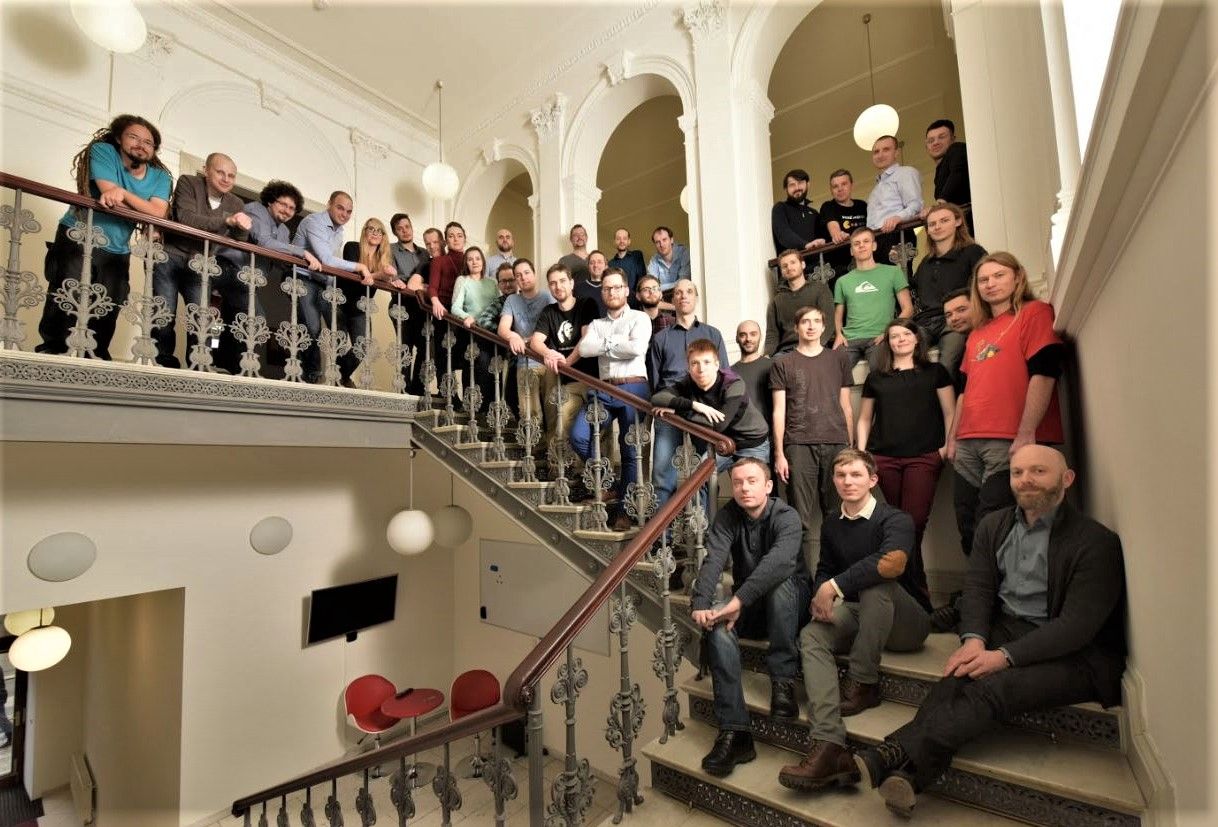
Matthew Gertner: Software and Spice and Everything Nice
Working in the same room as Salsita’s Founder and CEO Matthew Gertner has allowed me to observe him better than most of my colleagues. He seems to do everything at full speed: talking, typing, and walking from meeting to meeting with a fresh cup of tea...
Table of Contents
Working in the same room as Salsita’s Founder and CEO Matthew Gertner has allowed me to observe him better than most of my colleagues. He seems to do everything at full speed: talking, typing, and walking from meeting to meeting with a fresh cup of tea. Like a comedian who's always “on,” Matt approaches his work with a breakneck intensity.
Salsita Software is turning 10 years old this month. Over the past decade, this company has grown steadily. Salsita started with only three employees and, when the doors officially opened, there were no doors to open: there was no office yet and everyone was working from home. Now Salsita has over 80 staff split between a 1000 m2 headquarters in Prague and a smaller office in Ostrava, Czechia's third largest city.
Salsita Software is Matt's third company. His story doesn’t begin or end with Salsita, but software and programming are ever-present themes. Some people float from job to job without ever knowing what they want to be when they "grow up," while others have had a clear vision of their future since they were kids. Matt squarely resides in the latter category.

CALCULATING MINDSET
Matt’s first exposure to programming was at the age of eight. His father was trying to program a formula into his late-70s HP-34C scientific calculator. When he couldn’t figure it out, Matt gave it a go. “I found the idea of programming interesting, so I took the calculator’s manual and figured out how to write the program on my own,” said Matt.
A couple of years later, Matt’s father bought a desktop computer and the Mark Williams C compiler. The compiler was incredibly slow, which meant Matt’s programs could take 10-20 minutes to compile. “Programming in C isn’t something I’d necessarily recommend teaching a 10-year-old, but that’s what was available,” said Matt. To minimize compile time, he would write hundreds of lines of code before launching the compiler, take a break and then come back 20 minutes later to fix any errors.
In 1983, Borland released Turbo Pascal. Unlike Mark Williams C, it had a built-in editor and blazing fast compile times. “You got feedback in real-time and could be more productive than with the C compiler,” said Matt. This meant that he could compile more often without taking a break, considerably speeding things up.
During this time, there were two programming successes he remembers fondly. The first was a simple racing game he created in C. It ran too slowly for his taste, so Matt taught himself assembly language to speed things up. The result was too fast for human reflexes to keep up with, and he actually had to add code to slow it down.
The programming feat he was proudest of was an online bulletin board system (BBS) that he wrote from scratch. These systems were pre-Internet online communities with features like discussion forums and file downloads, and were a precursor of today's Internet and social networks.

“I really got into the BBS scene and at some point I thought it would be an interesting challenge to write my own,” said Matt. “It was educational and a way to show off to my friends in the BBS community.” He named his BBS Rainbow’s End, after his DEC Rainbow 100 computer. Cultivating this little community with software that he had written himself further reinforced how satisfying programming could be.
The best thing about software development is that you are really creating something. It has a very concrete form in a lot of cases because you can see and use it. It has value and you can show it to your friends, you can impress them and so on. It really deepened my conviction that that was what I wanted to do for a career. From around the time I was 12, I had no doubt that I wanted to be a computer programmer when I grew up.
FOUND IN TRANSLATION
While Matt’s programming skills evolved, another subject took hold and turned into a lifelong interest. Matt first got into languages during 5th grade. Given the choice at school between Spanish and French as his first foreign language, he chose Spanish. When the school mistakenly put him into French, he decided to stick with it. This innocent oversight ended up having a profound influence on his life, starting with the couple of summers during high school that he spent as an exchange student in France.
At university he decided to study linguistics. “By the time I started university, I thought I was the greatest programmer in the world, like most 18-year-old geeks,” said Matt. “I figured it would be a waste of time to study computer science.” During his second year at university he had the opportunity to take a computational linguistics class that combined both of his passions.
“I found it super interesting and it made it clear to me that I actually didn’t know everything there was to know about programming,” said Matt. “And that’s when I decided to get a computer science degree as well.” As he would soon find out, that computer science degree would be of more use than his linguistics degree when he went after his first job.

While still at university, Matt spent a summer programming for a friend of his father's in Paris. He fell in love with the city and decided to move there after he graduated. He arrived in Paris in the midst of a major recession and was fighting with most of the country to secure a job. Matt sent out armloads of resumes and got back a trickle of responses…all rejections.
In desperation he decided to take advantage of the one thing that set him apart from most other programmers: his linguistics degree. This was the pre-web era, so he went to the public library in the Georges Pompidou Center to consult the Kompass company register, a massive hardcover tome. He found three Paris-based companies that were doing something related to linguistics and computer software and wrote to all of them. To his surprise, one wrote back and wanted to meet.
Linguistique Communication Informatique (LCI) urgently needed to test an application for a large US client that had been localized from English to French. LCI had a number of native French-speaking translators, but they weren’t adept at finding the nooks and crannies of a software application.
Highly motivated to take advantage of this opportunity, he leveraged his computer background and ended up finding more bugs than anyone. “I had an application to Burger King sitting on my kitchen counter, so I worked my butt off because this was my shot to get a proper job instead,” said Matt. A week after testing ended, Matt got a call from LCI's boss.
Erik’s dream was to make a sophisticated terminology management application for professional translators. He heard I had done a good job on that testing project and was intrigued by my background in both software development and linguistics. This was my dream job because it was a real programming job related to languages. It was a huge breakthrough for me.
Matt spent the next three years at LCI writing various language-related software.
HEAD EAST, YOUNG MAN
LCI started using an object-oriented database system developed by POET Software, a small start-up in Hamburg, Germany. Erik recognized this as a unique technology and agreed to market the database package in France. This business opportunity for LCI turned out to be the next step in Matt’s career.
“POET’s head of development, Joerg Tewes, was in Paris for a consulting gig and he invited me out to dinner,” said Matt. “I told him that I wasn’t entirely happy with my job and he said, ‘Why don’t you come to Hamburg and work for us?’”
Matt had been complaining to Joerg for some time that the POET database didn't handle lexicographic sorting properly. “When you sort real languages, you can’t just do it alphabetically,” said Matt. “You need to take into account diacritics, non-Latin characters, etc. When you're writing a terminology management application and your database doesn't sort natural languages properly, that's a problem.” To address this, Matt wrote a 20-page spec on how to do efficient lexicographic sorting of database collections and sent it to POET, where it languished.
On his first day at POET, Joerg walked over to Matt's desk and tossed the spec onto his desk. "Welcome to POET, Matt," he said. "You wrote this spec and now you get to implement it!" Matt spent three years in Hamburg at POET Software working as a developer and project manager before continuing east again.
In early 1997, a friend from Matt’s LCI days contacted him about an IT services company that he wanted to start in Prague. "I visited Prague and immediately liked it,” said Matt. “I was ready to make a move and I was still young and single, so I was like 'why not move to Prague and start a company?'”
Praxis, a software services company, was essentially an earlier version of what Salsita is today. They were mainly doing C++ and Java development. One of their first hires was Simona Tymichová, who came on board to help with the administrative work and has been working with Matt ever since across three companies and over 20 years.
After a couple of years, Praxis rebranded as Schemantix and began to focus on the emerging new XML standard. The dotcom boom was in full swing, and deals were relatively easy to land, even without the aid of social media and Google ads. Then, in late 2000, the dotcom bubble burst. “It was suddenly impossible to sell anything,” said Matt. “It was pretty brutal, and we were forced to close the company. To this day that was probably the most difficult period of my professional career.”
After freelancing for a couple of years, Matt visited another friend and former colleague from his LCI days, Cedric Maloux, at his home in France. Cedric had been mulling over an idea for a new kind of online community that would use peer-to-peer (P2P) technologies to lower infrastructure costs. They ended up co-founding AllPeers, which morphed into a tool for creating ad hoc private file sharing communities using P2P. “Rather than making a standalone app, I pushed to make it a Firefox extension,” said Matt. Firefox was a new browser at the time and his thinking was that it would get them a fair amount of attention. The gamble paid off.
TechCrunch founder Mike Arrington interviewed Matt and Cedric and wrote a glowing article about AllPeers. Within a few days, they had more than 50,000 people signed up despite having yet to release anything. “We had raised some angel funds but were struggling to land VC investment,” said Matt. "After the TechCrunch article, that was no longer a problem." The article set off a firestorm of calls from investors. Soon they had two top European VCs investing in their company. Matt and Cedric had 10-12 people working for AllPeers at its peak and around 50,000 monthly active users. But they failed to reach what their investors felt was a critical mass of users and closed the company in 2008.

Matt went back to freelancing. Having forged close ties with the Mozilla community as the developer of one of the first high-profile Firefox extensions, Matt was put in charge of a Mozilla Labs project called Prism. This led to a consulting gig for Zimbra, a well-established start-up that had been recently acquired by Yahoo. “Prism was basically a proof-of-concept at that point, and they needed someone to turn it into a production-quality product,” said Matt. “I had been doing most of the development on it, so I was the obvious choice. That kind of launched a new phase of my freelancing career.”
People started to take notice, and over time, Matt built up his client base. “I had more work than I could handle but didn’t want to turn down projects,” said Matt. He rehired Simona, his office manager from his days at Schematnix and AllPeers, who had just started working in a bank. “I was really unhappy there and, after meeting Matt at a concert in Archa, I asked him if he was thinking about opening another company,” said Simona. Matt suggested that she join Salsita on a part-time basis and help him to build up his new venture.
SPECIAL SAUCE
Matt’s reason for starting Salsita was simple, “I just wanted to hire a developer to help me,” he said. “It wasn’t like I had this idea of trying to grow a big service company. That just sort of happened by itself.”
The name of the company also resulted from a spark of serendipity. While vacationing in Spain, he was mulling over possible names with his girlfriend (and now wife). He wanted a short, brandable, pronounceable name rather than a clumsy buzzword that just happened to have a .com domain available. "There was this blackboard on the wall of the restaurant with some daily specials on it and it said ‘SALSA’ in big letters,” said Matt. “I thought that would be an awesome name.” Unfortunately, the name “Salsa” was already registered by another company in the Czech Republic.
“I was really disappointed. But a day or two later I remember waking up in the middle of the night with the name Salsita in my head,” said Matt. “I liked the balance—not too common, not too obscure. In a way it was better than Salsa because it's more distinctive.”

When Simona told Matt that her husband Oskar, a graphic designer, had created a logo for Salsita, he was initially skeptical. "I was expecting an awkward conversation where I had to explain to her that I hated her husband's logo," said Matt. Fortunately, he loved it. “The whole idea of having the chili as the logo came from Oskar. It’s had a huge impact on the company and our branding, just because he had been noodling around on a piece of paper.”
(NOT) JUST BROWSING
Salsita Software opened for business in June 2010. Salsita’s first developer was Tomáš Brambora, who previously worked at CZ.NIC, which runs the Czech internet domain, as a Python developer. During his time at Salsita, he worked as a JavaScript/Clojure developer and team lead.
“I interviewed with Matt at a café and he asked me a few questions and gave me an interesting challenge to solve: How would you implement an algorithm for an elevator?” said Tomáš. “We didn't have an office yet, so Matt bought an iMac for me and I worked from my bedroom for a couple of months.”
In August, the first office was set up in Palac Austria, a 19th-century mansion in the Anděl district of Prague that had been renovated to house a number of commercial units of various sizes.
Matt tapped into the niche market of browser extensions to get Salsita off the ground. “There weren’t too many people developing extensions, which is what you want when you're a small agency that is just getting started,” said Matt. “You don’t want to compete with bigger companies. You want to be doing something very specific.”
Most of their early gigs came by word of mouth or from Matt’s existing clients. “One of the influential events of that period was when we got a client, Brad Byrd, who wanted us to build a browser extension to customize the Google AdWords interface,” said Matt. Brad had sold his previous company and was working from his home in Northern California. They got to know each other through regular online chat sessions and struck up a friendship.

Matt had tried advertising Salsita's browser extension services on Google, but the ads weren’t performing well. Brad, an online marketing specialist, offered to have a look. They agreed to a barter arrangement, and Brad set up some far more sophisticated and effective ad campaigns. “We gave Brad some free development work but it was totally worth it because AdWords became our primary marketing channel,” said Matt. From there Salsita entered a new high-growth phase.
After a year, Salsita had outgrown their 80 m2 office and moved to a larger space in Palac Křizík, a nearby office building owned by Czech search behemoth Seznam. They had also outgrown the browser extension niche. Matt and Brad (who had meanwhile come on board as Chief Operating Officer and remained with the company until 2018) decided to expand their focus to the broader field of web app development.
Right on cue, they learned that a British software company was closing their Prague-based development office. Salsita interviewed a number of their newly unemployed developers and hired several, four of whom—Filip Naumovič, Alex Khrapko, Irina Gvozdeva, and Daniel Prentis—still work at Salsita eight years later.
Matt told me about some projects he had in mind and he was so excited about them. It was clear that the team around him could build anything they wanted. Also, Matt was a developer with a great background. Salsita felt like a perfect environment where people are driven by ideas and tech. – Alex Khrapko, Full-Stack Developer
This infusion of web development talent steered Salsita in the direction that Matt and Brad had envisioned. “Filip and Alex were the first members of our team who knew about web development and that bootstrapped our efforts to expand into that field," said Matt. They adjusted their marketing goals and started running campaigns for web development.
Right around that time, Google came out with a new framework for making so-called "single-page web applications" (SPAs) called AngularJS. SPAs were the new style of web apps that felt slicker and more like native desktop apps. There were competing frameworks on the market with bizarre names like Ember, Batman and Knockout, but Matt felt Angular’s approach was the best in its class. As a bonus, it was backed by Google. Overall it felt like the safest bet.

The bet paid off as Angular experienced a surge in popularity. This allowed Salsita to hire more developers and, by March of 2013, they had 25 staff. Salsita sought a bigger space and found one at the site of their first office—Palac Austria. They've been there ever since.
FULL SPEED AHEAD
Running a growing service company is a constant race to keep up with market conditions, competition, and new technologies. "You can't just sit back and watch the money roll in," explained Matt. "The sales and marketing you were doing last year might not work at all this year." Salsita branched out into React, Facebook's answer to AngularJS, in 2014 and most of their current projects use this framework. They also expanded into mobile apps, mainly using React Native, a companion technology to React that lets you build truly native mobile apps for iOS and Android using open web technologies.
Over the past couple of years they’ve begun to focus more on user experience (UX) and product design, making a number of key hires in this area. Nowadays their projects tend to start with a UX workshop to nail down the details of the app to be developed, prototype it and test it on real users before a line of code is written.
They've also expanded their marketing team, distributing content across multiple marketing channels and using Facebook and LinkedIn ads in addition to Google. Taking advantage of the expertise garnered through their own marketing efforts, Salsita has also begun to offer digital marketing services to clients, helping them to expand their customer base and reach new markets.
Another barrier Matt had to overcome was recruitment. “We initially worked a lot with recruitment agencies, but I wasn't thrilled with the results,” said Matt. "They are expensive and you know they are going to send the best candidates to some bank who is paying them more than you are." The solution was to hire in-house recruiter Marketa Tuláčková. She helped turn Salsita into a recruitment powerhouse, whose biggest strength is arguably recruiting great developers.

Recruiting is only half the story. When you hire great talent, you want to keep them at your company for as long as possible. I often say that our core competence is hiring and retaining great developers. As much as anything, that is what’s driving the company forward. Every developer on our team probably gets multiple job offers every week on LinkedIn, and that applies equally to QA, UX designers, DevOps engineers, and other roles. So we spoil them rotten with great offices, free food, flexible hours and the opportunity to work with the latest, greatest technologies.
The company even rented the vacant music club in the basement of their building and renovated it to create a private meeting and recreational space.
More than anything, though, the staff appreciates the opportunity to work with a team of smart, motivated, and experienced individuals. “Feeling average among a bunch of superheroes is better than being a superhero among a bunch of average people,” said Tech Lead Jiří Staniševský. “That's how I felt when I joined Salsita. The concentration of smart, friendly, and helpful people is amazing and I've learned more during my first year here than in the last four years of my career.”
June 2020 marks 10 years since Matt founded Salsita. He doesn’t attach much importance to this anniversary though. He prefers to focus on the company’s accomplishments, rather than the time it took to achieve them. “It's more about achieving something concrete, whether it takes you one year or 10 years,” said Matt. “And while I feel like we've accomplished a lot, there's still a hell of a lot more to do.”









